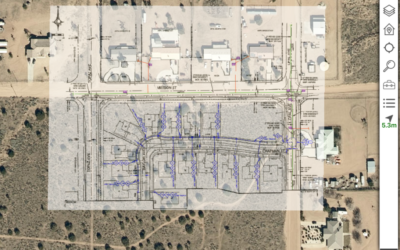Modern mobile mapping ensures streamlined processes and greater accuracy.
The growth and challenges of modern field service
The role of field service management continues to dominate the world economy, as the market grows at an exponential rate. The market was estimated at 3.2 billion in 2021 and is projected to reach 5.7 billion by the end of 2026. This includes field services industries such as utilities, oil and gas, government, and transportation.
As the role of field services expands, so does investment in IT. Companies are digitally transforming with enterprise solutions like ERP and CRM and extending that business intelligence with add-on apps like work order management. They employ a growing number of mobile solutions to extend those modernization benefits to field crews. Adding to the complexity are increased regulations, hyper-competitive markets, and ever-changing consumer demands for faster service.
Technology alone is not enough. The multitude of toolsets leads to an overly complex infrastructure, leaving IT departments struggling to keep their enterprise connected and effective. Field crews sometimes use more than fifty mobile solutions that work independently, adding time and increasing risk. And these applications often don’t work offline, where critical work like damage assessment is performed outside of internet availability.
What’s needed is an enterprise approach that connects systems and applications already in-place, allowing workers to perform all their tasks using a single mobile solution.
That’s where modern mobile mapping makes a difference. Integrating enterprise GIS, work order management, and more, field crews replace clipboards and paper maps with a single enterprise-wide solution to perform mobile work. These can span from vegetation management to damage assessment to as-built documentation, all within one solution. This means staff operate faster, safer, and with greater accuracy while the organization simultaneously brings higher-quality service and products to their customers.
Modern mobile mapping provides:
- Increased efficiency
- Lower costs
- Improved operations
- Reduced risk
- Enhanced collaboration
The problem with traditional methods and apps
Even in the digital age, where data and mobility reign supreme, many of today’s field service divisions operate using paper and manual methods. Workers with digital apps on mobile devices still carry paper maps of assets and infrastructure. Cumbersome, antiquated, and not easily edited or amended, these traditional methods add time to work orders and delays to back-office data entry.
And while companies have invested more money into enterprise work order management, it often doesn’t work well with mobile apps, resulting in slower execution of tasks such as asset inspections, as-built documentation, and redlining. This increases risk due to data redundancy, re-entry, and inaccuracy, ultimately reducing field crews confidence in the information they take with them.
In addition, as organizations carry out digital transformation, they increase IT complexity. For instance, many companies today are implementing the Esri Utility Network Management Extension as part of their enterprise GIS efforts. Changes in ERP applications have also prompted companies to upgrade. As more software and apps get added into the mix, costs increase, as does maintenance work and software knowledge demands.
Companies looking to solve these problems typically have two options:
- Work order management systems that attempt to include GIS
- Mobile GIS that provides work order functionality
Both approaches fall short of performance and robustness expectations. Work order management software lacks the location-based query, asset connectivity information, and in-field redlining capabilities of geospatial technology; and GIS software is limited in its resource and inventory information, time logging, permissions, and documentation of work order processes, including workflow management toolsets. Both platforms struggle with working offline.
Attempting to run several field applications requires opening multiple interfaces, repeatedly inputting the same data into databases, and executing data transfer “handshakes” via ETLs or manual entry. This increases the potential for data errors or inaccuracies. With some organizations having over 50 apps, and each app processing 1,000+ transactions daily, that can lead to tens of thousands of data fidelity risks every day.
Mobile field service challenges:
- Paper-based methods or in-house solutions
- Disconnected field service management and GIS
- Data fidelity risks due to data “handshakes”
- Limited capabilities when offline
- Slow performance and data load limitations
Combining work order management and GIS
Modern mobile mapping delivers on the promise of better field service management by integrating GIS and work management and removing complexity for users.
Modern mobile mapping leverages system of record data from existing work management, EAM, and GIS software while operating at incredible speed and performance. Whereas traditional mapping apps take a GIS-focused approach that requires training on GIS functions and methodologies, modern mobile mapping introduces powerful yet easy to use tools focused on field service workflows. It brings a seamless, fast-performing experience to both online and offline environments so staff can complete work anywhere. And it requires zero GIS knowledge and very little training.
Teams can replace paper-based methods to digitally document conditions on the ground, update attributes, redline maps, and capture data. It provides a spatial reference, GIS information, and editing for workflows to improve inspections, asset verification, data updates, modeling, and more. Perhaps most importantly, combining GIS and work order management replaces the waste inherent in multiple-point solutions.
Modern mobile mapping lets field crews do their jobs without manually opening and switching between multiple windows. It makes workflows more efficient by delivering GIS map interaction and functionality through a field service management UX/UI that’s easy to understand.
Modern mobile mapping solution:
- Reduce errors with integrated GIS and field service workflows
- Work efficiently with fast rendering regardless of connectivity
- Accelerate construction to as-built in record time
- Capture and correct data in the field
- Ensure adoption and minimize training
Lemur delivers modern mobile mapping
Designed to meet field worker needs while reducing business risks and IT complexity, Lemur delivers on the promise of modern mobile mapping. Lemur offers a scalable solution that works seamlessly with enterprise platforms —whether for hundreds or thousands of users. It fits with your existing IT infrastructure and includes templates, data models, and samples for specific use cases.
Lemur’s modern mobile mapping gives users an intuitive experience that requires minimal training and can be tailored to their specific workflows. It allows users to carry out tasks such as:
- Locate assets and view details
- Understand network connectivity
- Record work and asset corrections
Since Lemur can be tailored to workflows, staff only see the relevant data and actions they need for their assigned work. For example, companies can enable optional functionality to capture GIS features for as-built surveys with survey-grade external GPS equipment. They can can pre-populate collected data and forms to reduce errors and manual entry.
Lemur enables the real-time collection of GIS data updates while in the field, lowering correction times from months or years to hours or days. Remote workers can identify, remove, and edit inaccurate asset records by sending a direct digital update request to the back-office.
The result? Field crews leverage a single solution to work faster, safer, and smarter while enhancing enterprise data quality with in-field feedback during their daily activities.
Lemur improves multiple workflows:
- Vegetation management
- Damage Assessment
- Inspections, maintenance, and repairs
- Leak detection and management
- Network management
- Safety and compliance
- As-built documentation
- Pre-construction surveys
Bring the power of location to the field
As more companies digitally transform, they face the challenge of disparate systems, overly complex IT, and high app counts. Without a complete view of assets, environmental context, and network connectivity, they can’t operate efficiently in the field. The solution to these challenges is modern mobile mapping, which integrates GIS with workflow details, work order editing, inventory, time logs, expenses, security, and more.
With modern mobile mapping, specifically Locana’s Lemur solution, companies optimize their field workforce while improving the overall business. It combines Esri GIS with leading field service solutions from SAP, Salesforce, and others. With integrated functionality and tools, field staff no longer need to switch between multiple apps. Instead, they use an intuitive field application that requires minimal training to perform tasks with greater efficiency, safety, and accuracy online and offline.
•••
Want to learn more about how to transform your field service with modern mobile mapping? Visit the Lemur solution page or read the white paper.


